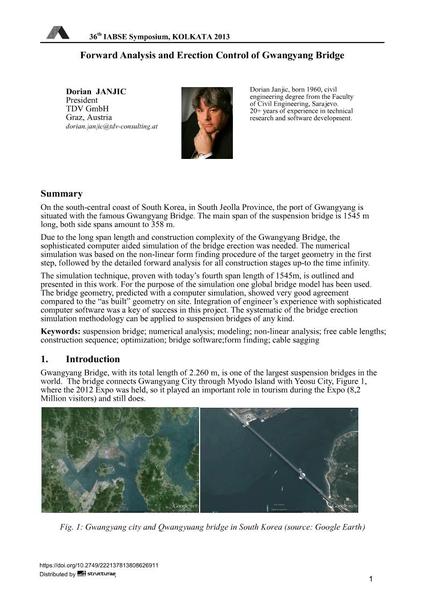Forward Analysis and Erection Control of Gwangyang Bridge

|
|
|||||||||||
Détails bibliographiques
| Auteur(s): |
Dorian Janjic
|
||||
|---|---|---|---|---|---|
| Médium: | papier de conférence | ||||
| Langue(s): | anglais | ||||
| Conférence: | IABSE Symposium: Long Span Bridges and Roofs - Development, Design and Implementation, Kolkata, India, 24-27 September 2013 | ||||
| Publié dans: | IABSE Symposium Kolkata 2013 | ||||
|
|||||
| Page(s): | 1-8 | ||||
| Nombre total de pages (du PDF): | 8 | ||||
| Année: | 2013 | ||||
| DOI: | 10.2749/222137813808626911 | ||||
| Abstrait: |
On the south-central coast of South Korea, in South Jeolla Province, the port of Gwangyang is situated with the famous Gwangyang Bridge. The main span of the suspension bridge is 1545 m long, both side spans amount to 358 m. Due to the long span length and construction complexity of the Gwangyang Bridge, the sophisticated computer aided simulation of the bridge erection was needed. The numerical simulation was based on the non-linear form finding procedure of the target geometry in the first step, followed by the detailed forward analysis for all construction stages up-to the time infinity. The simulation technique, proven with today’s fourth span length of 1545m, is outlined and presented in this work. For the purpose of the simulation one global bridge model has been used. The bridge geometry, predicted with a computer simulation, showed very good agreement compared to the “as built” geometry on site. Integration of engineer’s experience with sophisticated computer software was a key of success in this project. The systematic of the bridge erection simulation methodology can be applied to suspension bridges of any kind. |
||||
| Mots-clé: |
pont suspendu
|
||||
